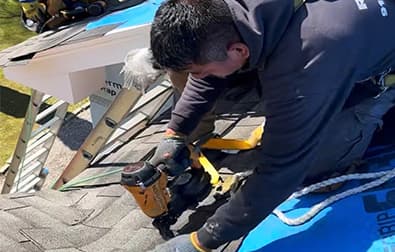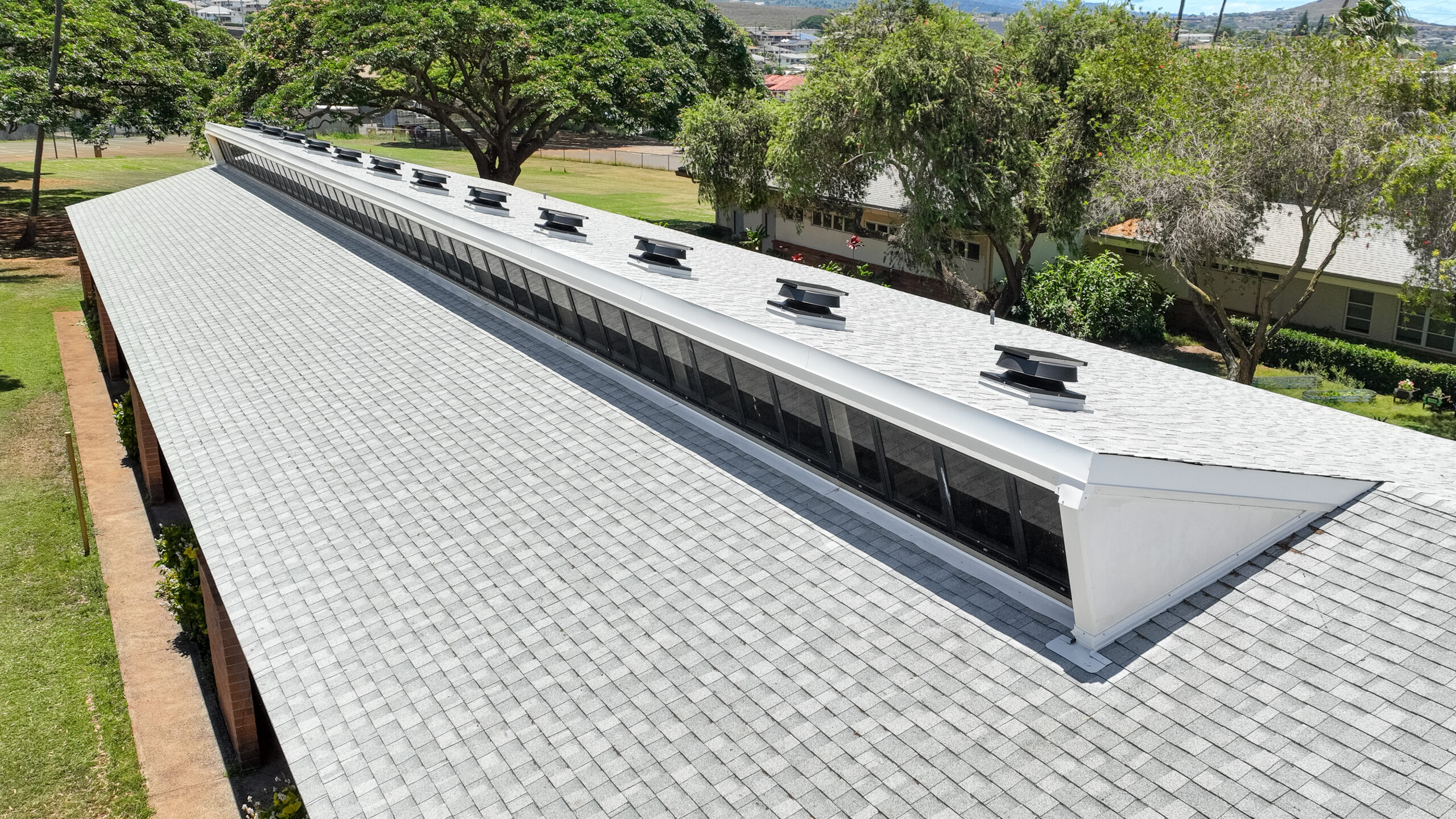Uncover Common Roof Covering Troubles and How to Address Them Properly
When it pertains to your roofing system, finding problems early can conserve you time and money. You may see water discolorations on your ceiling or broken roof shingles throughout your routine checks. Neglecting these signs can result in bigger issues down the line. Understanding just how to identify and address these typical roofing problems is vital for keeping your home's stability. What specific actions should you take to assure your roof continues to be in top problem?
Determining Roof Leakages and Their Reasons

Following, analyze your roofing system from the outside. Seek missing or cracked floor tiles, rusted blinking, or harmed gutters. Pay interest to areas around chimneys, vents, and skylights, as these prevail leak resources. If you identify any of these problems, it's crucial to resolve them promptly.
During heavy rainfall, observe your roofing system for any merging water or drips. This can disclose leakages that might not be noticeable throughout dry conditions. By staying watchful and frequently checking your roof, you can capture leakages early and protect your home from further damages.
Handling Missing Out On or Damaged Roof Shingles
When you discover missing out on or damaged shingles, it's vital to act quickly to stop more problems. You'll intend to recognize the degree of the damage, fix any kind of missing out on shingles, and consider precautionary upkeep tips to keep your roof in leading shape. Taking these actions can save you time and cash later on.
Determining Roof Shingles Damages
Although shingles are developed to hold up against the components, they can still suffer damages in time, bring about possible leakages and costly repair services. To identify shingle damage, begin by examining your roofing system for missing out on, split, or crinkled roof shingles. Search for indicators of discoloration or granule loss, which can suggest wear and tear. Focus on any areas where roof shingles are lifting or bending, as these can produce vulnerabilities. It's additionally smart to check for water stains or mold and mildew on your ceilings and walls, as these may signify leaks stemming from damaged shingles. Consistently checking your roof, especially after severe climate, can assist you capture concerns early and preserve the stability of your home.
Repairing Missing Roof Shingles
After detecting shingle damages, the following step is resolving any type of missing or damaged shingles without delay to protect against further issues. If you can, climb onto your roof securely, using appropriate gear. Taking activity quickly will help keep your roofing's integrity and expand its life expectancy.
Preventive Maintenance Tips
Just how can you keep your roof in leading shape and protect against roof shingles from going missing out on or obtaining damaged? Normal evaluations are key. Inspect your roofing system at the very least twice a year and after extreme weather. Try to find indicators of wear, such as curling, fracturing, or loosened tiles.
Keep seamless gutters clean and cost-free of debris to ensure correct water flow and prevent shingle damages. Trim overhanging branches to minimize the threat of them scuffing versus your roof during tornados.
Think about using a protective sealant to expand your tiles' lifespan. If you see any kind of problems, address them promptly to avoid costly repair services later. Taking these preventive measures can save you money and time while ensuring your roofing system remains durable and trusted.
Understanding Roofing System Ventilation Issues
Proper roofing system ventilation is crucial for maintaining the longevity and effectiveness of your roof system, as it aids control temperature level and wetness degrees in your attic. Without ample air flow, you may deal with problems like excessive heat accumulation, bring about premature roof shingles degeneration, or enhanced humidity that can create mold growth and timber rot.
To assess your roof air flow, check for signs of getting too hot, such as distorted shingles or a warm attic room. Look for blocked vents, which can restrict air movement and trap warmth. You should guarantee your intake and exhaust vents are balanced, permitting for appropriate air exchange.
If you presume ventilation issues, take into consideration setting up extra vents or updating existing ones. Ridge vents, soffit vents, and gable vents can all enhance air flow. Attending to these issues quickly can safeguard your roof and save you from costly repair services down the line. Keep aggressive in maintaining your roofing system's ventilation to protect your home.
Resolving Roof Covering Moss and Algae Development
While you could value the natural appearance of moss and algae on your roofing, these microorganisms can result in substantial problems if left untreated. They catch moisture, which can result in shingle damage and leaks. To tackle this problem, start by removing any type of noticeable growth. Use a soft-bristle brush to gently scrub away the moss and algae, taking care not to harm your roof shingles.
Following, take into consideration using a specialized roofing cleaner or a blend of water and bleach to eliminate continuing to be spores. Routine assessments and maintenance will aid prevent moss and algae from returning, guaranteeing your roof covering stays in great shape for years to come.
Fixing Tornado Damage and Wind Issues
After a tornado, it's essential to examine your roof covering for damage triggered by high winds and hefty rainfall. Start by looking for missing out on or broken shingles, as these are usual casualties. If you discover any, it is essential to change them immediately to stop leakages. Next, inspect the blinking around chimneys and vents; harmed flashing can cause water penetration.
Try to find any kind of drooping areas, which might show water accumulation or architectural problems. If you locate any type of particles, like branches or leaves, remove them thoroughly to stay clear of further damages. If your gutters are blocked, clear them to ensure proper drain.

For small repair services, you may manage it yourself, however do not think twice to call an expert for considerable damage. Remember, acting swiftly can conserve you from bigger troubles down the line, so take that assessment seriously and address any type of problems immediately.
Identifying Signs of Architectural Damage
Just how can you tell if your roofing system is struggling with architectural damages? Start by seeking noticeable sagging or dips in your roofline. These indicators show that the underlying framework might be jeopardized. Next off, check for fractures or spaces in the walls or ceiling, as these can signal moving or clearing up because of roofing problems. Take note of leaks or water stains, especially in areas where the roof meets walls. If you see missing or damaged shingles, it's vital to address them quickly, as they can subject your roofing system to further damage. Also, inspect your attic room for any type of indications of daytime peeking via, which might imply roofing contractors oahu your roofing system's stability goes to risk. Pay attention for unusual creaking or standing out noises, as they might indicate structural stress and anxiety. If you observe any of these indications, it's time to get in touch with a roofing specialist for a thorough analysis.
Routine Upkeep Tips for Durability

Regular Evaluations Importance
Given that a roofing is your home's first line of protection against the aspects, regular assessments are essential for preserving its integrity. You need to check your roofing at least twice a year, preferably in springtime and loss, to catch potential concerns early. Maintaining up with these examinations can prevent expensive repairs down the line and prolong your roofing system's life-span, ensuring your home stays secure and audio for years to come.
Proper Rain Gutter Maintenance
Normal roofing examinations normally lead to the value of correct seamless gutter upkeep. Check your rain gutters for leakages or corrosion; they can create water damage to your roof covering and home. By complying with these tips, you'll prolong your rain gutters' life expectancy and secure your roof.
Frequently Asked Questions
Exactly How Can I Choose the Right Roof Covering Product for My Home?
To pick the appropriate roofing product for your home, take into consideration climate, sturdiness, and aesthetic appeals. Research choices like asphalt shingles, steel, or floor tile. Think concerning upkeep needs and budget plan to locate what suits you finest.
What Are the Signs I Required a Roofing System Replacement Instead of Repair Work?
If you observe extensive leakages, sagging, or missing out on tiles, you could require a roofing system replacement. If your roofing system's nearing its life-span or has substantial damage, it's time to consider a full replacement instead of just repair services.
Just how Typically Should I Schedule Specialist Roof Evaluations?
You ought to set up professional roofing system examinations at the very least yearly, ideally in springtime or autumn. This aids capture potential issues early, ensuring your roof stays in great problem and lengthening its lifespan.
Can I Mount a New Roofing System Over My Old One?
You can install a brand-new roofing over your old one, but it's vital to inspect neighborhood building regulations and guarantee the existing roof's condition is audio. This method can conserve time and cash, yet think about possible complications.
What Is the Average Life-span of Various Roof Products?
The average life-span differs by material: asphalt tiles last 15-30 years, steel roofings can last 40-70 years, while floor tile or slate roof coverings might go beyond 50 years. Choose carefully based upon your climate and budget plan.
Verdict
By remaining vigilant and resolving common roof issues immediately, you can shield your home and extend your roof covering's life expectancy. With a little routine upkeep, you'll not just secure your investment however also take pleasure in peace of mind knowing your roof is in leading form.